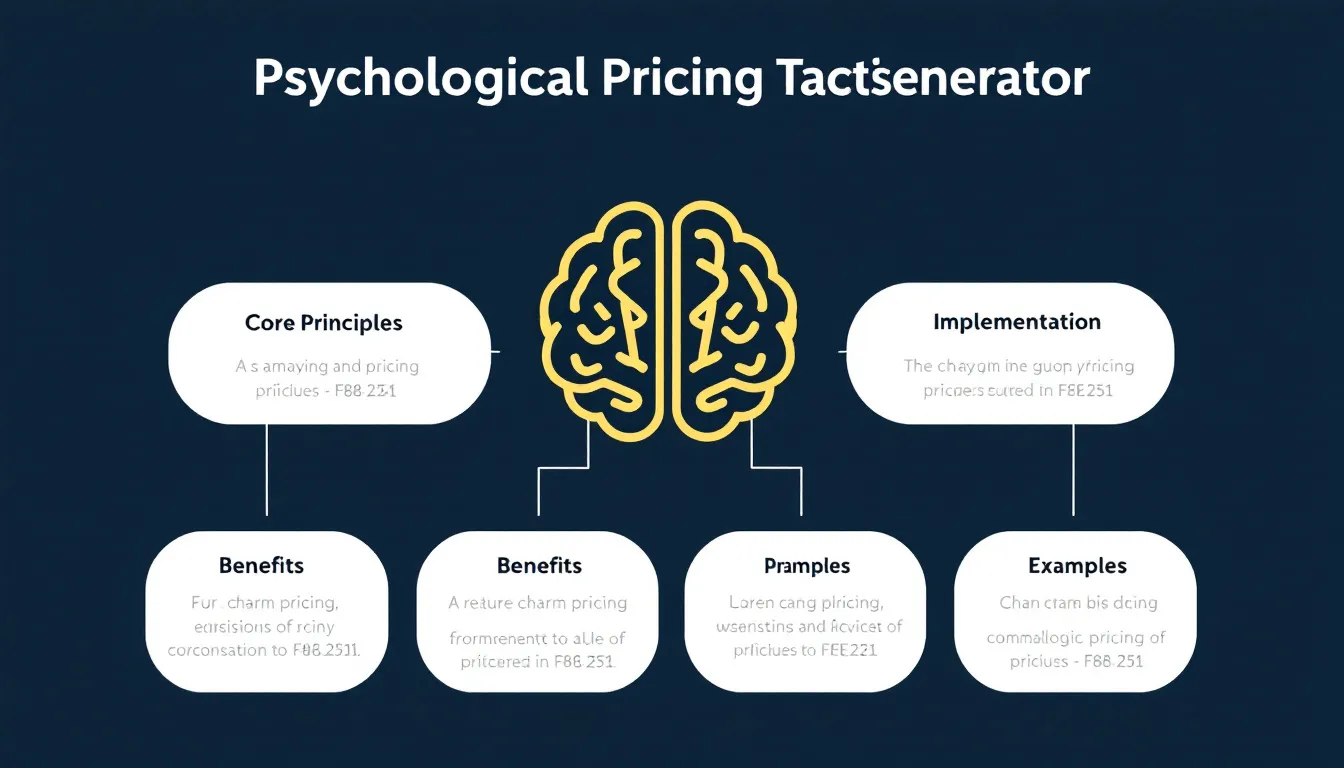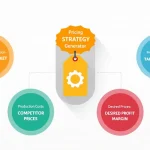Is this tool helpful?
How to Use the Psychological Pricing Calculator Effectively
To get the most accurate and actionable pricing recommendations from the Psychological Pricing Calculator, follow these steps carefully when filling out each field:
- Product or Service: Provide a clear description of your offering. For example, you might enter “Handcrafted leather wallets” or “Virtual language tutoring sessions”. This helps tailor suggestions to your specific product category.
- Target Audience: Describe the group of customers you want to reach. Sample inputs include “Young professionals aged 22-35” or “Parents seeking educational toys”. Understanding your audience sharpens pricing strategies to their preferences.
- Current Price (Optional): Enter your existing price or the price range you want to evaluate, such as 49.99 or 120.00. Though optional, this information helps the calculator produce recommendations aligned with your budget limits.
- Competitor Prices (Optional): List known competitor prices to improve relative positioning. Examples: “Competitor X: $59, Competitor Y: $79” or “Brand A: $25, Brand B: $30”. Including this info enables more market-relevant pricing advice.
Introducing the Psychological Pricing Calculator: What It Is and Why It Matters
The Psychological Pricing Calculator helps you apply proven pricing psychology tactics to make your product or service prices more appealing and effective. By analyzing the information you provide, this tool generates specific pricing recommendations designed to boost consumer interest and increase sales conversions.
Using data-driven insights rooted in consumer behavior, the calculator leverages pricing strategies like charm pricing, prestige pricing, and price anchoring to optimize your pricing structure. Whether you sell physical goods, digital products, or services, this tool adapts tactics to fit your market and audience.
Key Benefits of the Psychological Pricing Calculator
- Make informed, evidence-based pricing decisions based on psychological principles combined with your specific market data.
- Gain a competitive edge by positioning your prices strategically in relation to competitors.
- Increase your conversion rates with pricing that aligns with how customers perceive value and price attractiveness.
- Receive recommendations tailored to your product type, target audience, and price range.
Practical Use Cases: How the Psychological Pricing Calculator Supports Your Business
This calculator helps solve common pricing challenges by suggesting techniques suited to your unique scenario, such as luxury versus budget products or complex pricing tiers.
Example 1: Boutique Fitness Classes
- Product Type: “Yoga and mindfulness workshop series”
- Target Audience: “Health-focused adults aged 30-50”
- Price Range: $120-180 for a multi-session package
- Competitor Prices: $150 (local gyms), $175 (specialized studios)
The calculator might recommend:
- Using prestige pricing with round, whole numbers like $180 to suggest premium quality.
- Offering a bundle price for 5 sessions at $550 to encourage bulk purchase behavior.
- Highlighting a mid-tier option at $150 to act as a price anchor for perceived value.
Example 2: Digital Marketing Consulting
- Product Type: “Monthly social media strategy consulting”
- Target Audience: “Small business owners with limited marketing budgets”
- Price Range: $300-600/month
- Competitor Prices: $350, $550
Recommended pricing tactics include:
- Applying charm pricing such as $599 instead of $600 to create a perception of savings.
- Creating a decoy pricing tier for premium consulting at $650 to make the $599 plan more attractive.
- Suggesting a lower entry plan at $299 to hook price-sensitive customers.
Core Psychological Pricing Strategies Utilized
- Charm Pricing: Ending prices in .99 or .95 to encourage purchase decisions.
- Prestige Pricing: Using whole numbers for luxury or high-end products to evoke quality.
- Price Anchoring: Setting reference prices to guide customer perception of value.
- Decoy Pricing: Introducing a less attractive option to steer customers toward preferred choices.
- Bundle Pricing: Offering product combinations at a discount to boost average order size.
Frequently Asked Questions about Psychological Pricing
Why is psychological pricing so effective?
It taps into how people subconsciously evaluate prices, often focusing on emotional cues rather than pure logic. This approach increases perceived value and encourages quicker buying decisions.
How often should I revisit my pricing strategy?
Regular reviews every quarter help keep your pricing aligned with market trends and customer expectations, especially during sales peaks or economic shifts.
Can psychological pricing work for all price points?
Yes, from budget items using charm pricing to high-end luxury goods applying prestige pricing. The right tactic depends on your product positioning and target audience.
Should I apply the same pricing strategy across my entire product line?
No. Different products benefit from different tactics. Tailoring pricing by category and customer segment yields better results.
How do I combine multiple pricing tactics effectively?
Use complementary strategies such as pairing charm pricing with bundling or anchoring with decoy pricing to reinforce the desired customer perception without confusion.
How does market positioning influence pricing choices?
Your brand’s position in the market shapes which tactics to emphasize. Premium brands often highlight exclusivity with prestige pricing, while value brands focus on competitive pricing and perceived savings.
Do seasonal trends affect psychological pricing advice?
Yes, changes in customer demand during holidays or seasonal peaks impact which pricing strategies perform best. The calculator considers this when generating recommendations.
Important Disclaimer
The calculations, results, and content provided by our tools are not guaranteed to be accurate, complete, or reliable. Users are responsible for verifying and interpreting the results. Our content and tools may contain errors, biases, or inconsistencies. Do not enter personal data, sensitive information, or personally identifiable information in our web forms or tools. Such data entry violates our terms of service and may result in unauthorized disclosure to third parties. We reserve the right to save inputs and outputs from our tools for the purposes of error debugging, bias identification, and performance improvement. External companies providing AI models used in our tools may also save and process data in accordance with their own policies. By using our tools, you consent to this data collection and processing. We reserve the right to limit the usage of our tools based on current usability factors.







